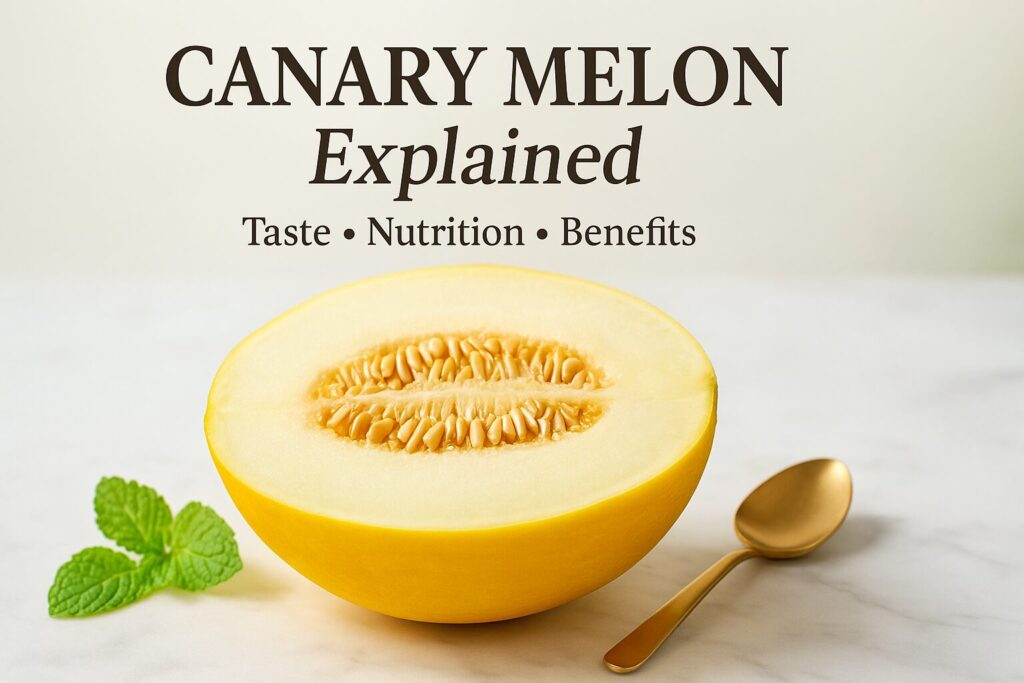Canary Melon is a sweet, hydrating fruit packed with Vitamin C, potassium, and antioxidants. Learn its taste profile, nutritional benefits, how to pick a ripe one, and delicious recipe ideas in this complete guide.
Table of Contents
Introduction to Canary Melon
Canary Melon is a bright yellow, sweet, and refreshing fruit that stands out not only because of its vibrant color but also for its unique taste and nutritional benefits. Its name comes from the Canary Islands, where it was traditionally cultivated, although today it is grown in warm climates across Asia, Europe, and the Americas. The fruit belongs to the Cucurbitaceae family, the same group that includes cucumbers, pumpkins, and other melons.
Unlike common melons like cantaloupe or watermelon, Canary Melon has a smooth, waxy rind and an elongated oval shape. When ripe, it develops a rich golden-yellow skin that contrasts beautifully with its pale green to white flesh. This distinct appearance often makes it an eye-catching addition to fruit markets and grocery shelves.
Canary Melon is appreciated for its refreshingly sweet flavor, high water content, and easy digestibility. It has become popular among people looking to add more hydrating fruits to their diet, particularly during hot seasons. Its subtle sweetness makes it suitable for both simple snacking and culinary experimentation.
Whether you’re discovering Canary Melon for the first time or looking to understand it more deeply, learning about its taste, nutrition, selection methods, and recipe uses can help you get the most out of this delicious fruit.
What Does Canary Melon Taste Like?
The taste of Canary Melon is its most distinctive feature. When ripe, the fruit has a sweet, mellow flavor that is often compared to a mix of pear, cantaloupe, and honeydew, but with a smoother and cleaner finish. Unlike watermelon, which delivers an immediate burst of sweetness, Canary Melon offers a gentle sweetness that gradually intensifies as you chew.
The texture is soft yet firm. The flesh is juicy but not watery, making it refreshing without being overly mushy. This pleasant balance of crispness and tenderness is one of the reasons many people prefer Canary Melon over other melons with grainier textures.
Here is what makes the Canary Melon taste unique:
- Sweet but mild flavor: Not overpowering, making it suitable for both sweet and savory dishes.
- Smooth and silky texture: Easy to bite and chew, great for children and seniors.
- Refreshing juice content: Hydrates the body, especially in warm climates or summer months.
- Clean aftertaste: Leaves a cool, soothing feeling in the mouth.
When compared to other melons:
| Fruit | Flavor Intensity | Texture | Aftertaste |
|---|---|---|---|
| Cantaloupe | Strong, musky | Soft | Slightly earthy |
| Honeydew | Mildly sweet | Juicy & smooth | Cool and mild |
| Canary Melon | Moderately sweet and bright | Firm yet tender | Clean and refreshing |
If the Canary Melon is not fully ripe, the flavor can be bland or slightly vegetal. This is why selecting a ripe one is crucial and we’ll explore this in detail later in the article.
When it is ripe, the fruit provides a delicate sweetness that makes it ideal for:
- Breakfast bowls
- Smoothies
- Fruit salads
- Hydration snacks
The taste profile is what makes Canary Melon a light, refreshing fruit perfect for those who want sweetness without too much sugar intensity.
Nutritional Profile of Canary Melon
Canary Melon is more than just a refreshing summer fruit it offers a strong nutritional profile that supports hydration, digestion, and overall wellness. Like most melons, it has a high water content, making it naturally low in calories, yet it still provides valuable vitamins, minerals, and antioxidants.
Below is the approximate nutritional value of 1 cup (about 170g) of sliced Canary Melon:
| Nutrient | Amount |
|---|---|
| Calories | ~50–60 kcal |
| Water Content | ~90% |
| Carbohydrates | 13–15g |
| Natural Sugars | 11–13g |
| Fiber | 1–2g |
| Protein | <1g |
| Fat | 0g |
| Vitamin C | ~30–40% of daily requirement |
| Vitamin A (as Beta-Carotene) | Moderate amount |
| Potassium | ~250–300mg |
| Folate | Small but beneficial quantity |
Key Nutritional Highlights:
- Hydration Power: The high water content helps maintain fluid balance and supports kidney function.
- Rich in Vitamin C: This plays an essential role in collagen formation, immunity, and skin repair.
- Contains Potassium: Helps regulate muscle function and blood pressure.
- Low in Calories & Fat: Ideal for weight management and light snacking.
- Natural Antioxidants: The presence of carotenoids supports cellular health and reduces oxidative stress.
Why These Nutrients Matter:
- Vitamin C in Canary Melon helps protect skin from sun damage and supports immune response.
- Potassium assists in balancing sodium levels, making the fruit excellent for individuals watching their blood pressure.
- Natural sugars offer quick energy without the heavy glycemic load of processed sweets.
Canary Melon’s nutritional profile makes it especially beneficial for athletes, students, elderly individuals, and anyone looking to stay hydrated while enjoying a light, tasty fruit.
Health Benefits of Canary Melon
Canary Melon offers a range of health benefits that come from its high water content, vitamins, minerals, and natural antioxidants. Because it is easy to digest and gentle on the stomach, it is suitable for people of all ages including children and those with sensitive digestion.
1. Supports Hydration and Electrolyte Balance
With nearly 90% water content and a meaningful amount of potassium, Canary Melon helps replenish fluids and electrolytes. This makes it excellent for:
- Hot summers
- Post-workout recovery
- Dehydration prevention
The fruit hydrates the body without adding heavy sugar or artificial ingredients, unlike packaged sports drinks.
2. Boosts Immune System Function
Canary Melon is rich in Vitamin C, which plays a central role in maintaining immune defense. This vitamin helps:
- Strengthen the immune system
- Improve white blood cell function
- Support faster recovery from common illnesses
Regular consumption can contribute to better resistance against everyday infections.
3. Promotes Digestive Health
Although Canary Melon is not high in fiber, it contains enough soluble fiber to gently support digestion. In combination with its hydrating properties, it helps:
- Improve bowel regularity
- Prevent mild constipation
- Soothe the digestive tract
Its soft texture makes it ideal for those recovering from digestive discomfort or illness.
4. Supports Skin Health and Collagen Formation
Vitamin C in Canary Melon aids in natural collagen production the protein responsible for firm, healthy skin. Consuming the fruit regularly may contribute to:
- Improved skin hydration
- Reduced dullness or dryness
- Better elasticity over time
Hydrated skin is naturally more vibrant and youthful-looking.
5. Helps Maintain Heart and Blood Pressure Health
The potassium found in Canary Melon helps relax blood vessels and balance sodium levels in the body. This can support:
- Stable blood pressure
- Reduced cardiovascular strain
- Improved circulation
For people focusing on heart health, replacing salty snacks with hydrating fruits like Canary Melon can be a smart choice.
6. Weight-Friendly and Satisfying
Because it is low in calories but naturally sweet and filling, Canary Melon works well for people managing their weight. It offers:
- A satisfying snack substitute
- Hydrating satiety without heaviness
- A way to reduce cravings for sugary foods
Eating Canary Melon before meals may reduce overall calorie intake.
How to Select a Ripe Canary Melon
Choosing a ripe Canary Melon is essential to enjoying its full sweetness and smooth texture. Unlike some fruits that continue to ripen significantly after being picked, Canary Melon develops most of its flavor on the vine, so selecting the right one at the store makes all the difference.
Here’s how to identify a perfectly ripe Canary Melon:
1. Look for a Deep, Golden Yellow Color
A ripe Canary Melon should have a rich, vibrant yellow skin.
Avoid melons that are pale, greenish, or dull these are likely underripe and will taste bland.
2. The Skin Should Be Waxy, Not Shiny
The rind should appear matte and slightly waxy, not glossy.
A shiny rind usually indicates the melon has been picked too early.
3. Check the Firmness
- Press lightly with your palm.
- A ripe melon will be firm but not rock-hard.
- There should be a slight give, especially at the blossom end (the side opposite the stem).
If it’s soft or squishy, it may be overripe and mushy inside.
4. Smell the Blossom End
Bring the melon close and smell the round end opposite the stem.
A ripe Canary Melon will have a sweet, fruity aroma.
No scent usually means it needs more time to ripen.
5. Check the Weight
A ripe Canary Melon should feel heavy for its size.
This indicates high water content and full juiciness.
Storage Tips
- Whole, uncut melon: Keep at room temperature for 1–3 days if slightly underripe. Once ripe, refrigerate.
- Cut melon: Store covered in an airtight container and refrigerate. Consume within 2–3 days for best flavor and freshness.
How to Eat and Serve Canary Melon
Canary Melon is versatile and easy to enjoy in many forms from simple slices to refreshing beverages and creative meal pairings. Its gentle sweetness makes it suitable for both sweet dishes and light savory combinations.
1. Basic Preparation
Start by washing the outer skin under running water.
Then:
- Cut the melon lengthwise.
- Scoop out the seeds using a spoon.
- Slice or cube the flesh depending on how you plan to serve it.
The flesh separates cleanly from the rind, making preparation easy even for beginners.
2. Simple Ways to Enjoy Fresh Canary Melon
Canary Melon is delicious on its own. You can:
- Eat it as fresh fruit slices.
- Add cubes to lunchbox snacks.
- Blend it with ice for a quick cooling drink.
Its clean aftertaste makes it a refreshing break between meals.
3. Pairing Canary Melon with Other Foods
Because the flavor is milder than mango or pineapple, it pairs beautifully with ingredients that add contrast:
- Mint leaves to enhance freshness.
- Yogurt or Greek yogurt for creaminess.
- Cottage cheese for a light, protein-rich snack.
- Lime juice to brighten sweetness.
- Prosciutto (for non-vegetarian diets) for a sweet–savory balance.
These combinations work well in both breakfast bowls and party platters.
4. Drinks and Smoothies
Canary Melon blends easily into beverages because of its natural water content.
Try it in:
- Hydrating smoothies
- Fresh pressed juice
- Infused water with cucumber and mint
It creates a cooling effect, especially when served chilled.
5. Dessert and Summer Treat Ideas
For a light, refreshing dessert:
- Freeze melon cubes and blend into a no-sugar sorbet.
- Serve chilled melon balls topped with honey and lemon zest.
- Layer melon slices with berries in fruit parfaits.
Canary Melon’s natural sweetness means additional sugar is rarely needed.
Canary Melon Recipes to Try
Canary Melon can be used in many refreshing and nutritious recipes. Below are simple and flavorful options that highlight its natural sweetness and smooth texture. Each recipe is beginner-friendly and requires minimal ingredients.
1. Canary Melon Smoothie
Ingredients:
- 1 cup Canary Melon (diced)
- ½ banana (for creaminess)
- ½ cup yogurt or plant-based yogurt
- A few ice cubes
- Optional: 1 teaspoon honey or maple syrup
Instructions:
- Add all ingredients to a blender.
- Blend until smooth and creamy.
- Serve chilled and enjoy immediately.
Why it works:
The banana adds creaminess while the Canary Melon provides a light sweetness and hydrating effect.
2. Canary Melon Summer Salad
Ingredients:
- 1 cup Canary Melon (cubed)
- ½ cup cucumber (thinly sliced)
- A handful of fresh mint leaves
- Juice of ½ lime
- A pinch of salt and black pepper (optional)
Instructions:
- Combine the melon and cucumber in a bowl.
- Add lime juice and gently toss.
- Sprinkle with mint leaves and seasoning.
- Serve cold.
Flavor tip:
The lime and mint bring out the natural sweetness of the Canary Melon.
3. Canary Melon Fruit Bowl
Ingredients:
- 1 cup Canary Melon (cubed)
- ½ cup grapes or berries
- ½ apple (thinly sliced)
- Optional: Chia seeds or sunflower seeds
Instructions:
- Arrange all fruits in a bowl.
- Sprinkle seeds for texture.
- Serve chilled.
Health note:
This is a great breakfast or pre-workout snack hydrating, light, and naturally energizing.
4. Chilled Canary Melon Soup (Refreshing & Light)
Ingredients:
- 2 cups Canary Melon (diced)
- ¼ cup coconut water
- 1 teaspoon lemon juice
- Pinch of fresh ginger (optional)
Instructions:
- Blend all ingredients until smooth.
- Chill for 1 hour before serving.
- Top with mint for garnish.
Serving suggestion:
Perfect on hot afternoons refreshing and calming.
Possible Side Effects or Allergies
Canary Melon is generally safe for most people and well-tolerated when eaten in normal amounts. However, like any food, there are a few considerations to keep in mind, especially for individuals with specific sensitivities or health conditions.
1. Mild Allergic Reactions (Rare but Possible)
Some people may experience allergic responses to melons due to cross-reactivity with pollen, particularly ragweed pollen.
Symptoms may include:
- Itching in the mouth or throat
- Mild swelling of lips or tongue
- Sneezing or watery eyes after eating
This condition is known as oral allergy syndrome (OAS). It is not common with Canary Melon, but it can occur in individuals already sensitive to pollen-based allergies.
2. Effects on Blood Sugar
Canary Melon does contain natural sugars. Although it has a lower glycemic impact than processed sweets, individuals with:
- Diabetes
- Insulin resistance
- Prediabetes
should monitor portion sizes. Pairing Canary Melon with protein or fiber, such as yogurt or nuts, can help slow sugar absorption.
3. Overconsumption May Cause Digestive Discomfort
Because Canary Melon has high water content:
- Very large servings may lead to bloating
- Or increased frequency of urination
Moderation is key. A standard serving of 1 to 1.5 cups is ideal for daily consumption.
4. Food Safety Considerations
Always wash the outer rind before cutting, even though the skin is not eaten.
This prevents transferring surface bacteria from the outside to the inside of the fruit.
Conclusion
Canary Melon is a naturally refreshing, mildly sweet fruit that stands out for its hydrating properties, smooth texture, and nutrient-rich profile. From vitamin C for stronger immunity to potassium for heart and muscle function, it offers meaningful health benefits without being heavy or high in calories. Its gentle sweetness and clean aftertaste make it enjoyable for people of all ages from young children to older adults seeking easy-to-digest foods.
Understanding how to choose a ripe Canary Melon is key to experiencing its full flavor. A rich golden-yellow color, a slightly waxy skin, and a sweet aroma at the blossom end are the best indicators of ripeness. Once selected, the melon can be served in a wide range of ways enjoyed fresh, blended into smoothies, paired with yogurt, or used in light salads and cooling summer recipes.
Because it is low in fat, easy to prepare, and naturally satisfying, Canary Melon is a smart addition to everyday meals, especially during warm seasons when hydration and light eating are important.
Whether you’re using it as a post-workout snack, a breakfast fruit, or a refreshing ingredient in summer dishes, Canary Melon brings both health and flavor to the table making it a fruit worth including in your routine.





